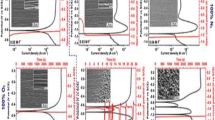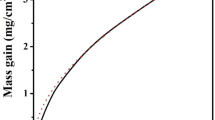Abstract
The effects of dissolved oxygen (DO) on the corrosion behavior of pure titanium in acidic fluoride-containing acids (pH = 0.6–2.0) were evaluated by electrochemical methods, such as open circuit potential (OCP) measurements, potentiodynamic polarization tests, and electrochemical impedance spectroscopy (EIS), combined with surface characterization by X-ray photoelectron spectroscopy (XPS). The results showed that DO affected the anodic kinetic parameters, except the passive current density, by decreasing the maximum anodic current density as well as influencing its dependence on pH and the fluoride concentration. However, DO had no detectable contribution to the total cathodic process at potentials in the active region of titanium. The critical fluoride concentration for the corrosion of titanium was consistently determined by means of three kinds of electrochemical methods. The critical value increased with the DO content, and its dependence on pH was also affected by DO, which were attributed to the effects of DO on the anodic parameters. Additionally, multiple corrosion potentials were discovered under some specific conditions with DO, which resulted from the non-negligible contribution of ORR to the total cathodic current density at relatively higher potentials.

ᅟ











Similar content being viewed by others
References
Cramer SD, Covino BS Jr, Moosbrugger C (2005) ASM handbook volume 13b: corrosion: materials. ASM International, Ohio
International Committee on Industrial Chimneys (1999) Model Code for Steel Chimneys. Zurich
Kelly JJ (1979) Influence of fluoride ions on the passive dissolution of titanium. Electrochim Acta 24:1273–1282
Sutter EMM, Goetz-Grandmont GJ (1990) The behaviour of titanium in nitric-hydrofluoric acid solutions. Corros Sci 30:461–476
Wang ZB, Hu HX, Liu CB, Zheng YG (2014) The effect of fluoride ions on the corrosion behavior of pure titanium in 0.05 M sulfuric acid. Electrochim Acta 135:526–535
Brossia CS, Cragnolino GA (2004) Effect of palladium on the corrosion behavior of titanium. Corros Sci 46:1693–1711
Wang ZB, Hu HX, Liu CB, Chen HN, Zheng YG (2015) Corrosion behaviors of pure titanium and its weldment in simulated desulfurized flue gas condensates in thermal power plant chimney. Acta Metall Sin (Engl Lett) 28:477–486
Nakagawa M, Matsuya S, Udoh K (2001) Corrosion behavior of pure titanium and titanium alloys in fluoride-containing solutions. Dent Mater J 20:305–314
Nakagawa M, Matsuya S, Udoh K (2002) Effects of fluoride and dissolved oxygen concentrations on the corrosion behavior of pure titanium, and titanium alloys. Dent Mater J 21:83–92
Kong DS, Feng YY (2009) Electrochemical anodic dissolution kinetics of titanium in fluoride-containing perchloric acid solutions at open-circuit potentials. J Electrochem Soc 156:C283–C291
Wang ZB, Hu HX, Zheng YG (2015) Determination and explanation of the pH-related critical fluoride concentration of pure titanium in acidic solutions using electrochemical methods. Electrochim Acta 170:300–310
Fovet Y, Gal JY, Toumelin-Chemla F (2001) Influence of pH and fluoride concentration on titanium passivating layer: stability of titanium dioxide. Talanta 53:1053–1063
Robin A, Meirelis JP (2007) Influence of fluoride concentration and pH on corrosion behavior of titanium in artificial saliva. J Appl Electrochem 37:511–517
Nakagawa M, Matono Y, Matsuya S, Udoh K, Ishikawa K (2005) The effect of Pt and Pd alloying additions on the corrosion behavior of titanium in fluoride-containing environments. Biomaterials 26:2239–2246
Wang ZB, Hu HX, Liu CB, Zheng YG, Ke W, Qiao YX (2016) Comparison of the corrosion behavior of pure titanium and its alloys in fluoride-containing sulfuric acid. Corros Sci 103:50–65
Baek WC, Kang T, Sohn HJ, Kho YT (2001) In situ surface enhanced Raman spectroscopic study on the effect of dissolved oxygen on the corrosion film on low carbon steel in 0.01 M NaCl solution. Electrochim Acta 46:2321–2325
Duan ZG, Arjmand F, Zhang LF, Meng FJ, Abe H (2015) Electrochemical and XPS investigation of the corrosion behavior of alloy 690 at high-temperature water. J Solid State Electrochem 19:2265–2273
Wang SX, Liu DX, Du N, Zhao Q, Liu SY, Xiao JH (2015) Relationship between dissolved oxygen and corrosion characterization of X80 steel in acidic soil simulated solution. Int J Electrochem Sci 10:4393–4404
Badea GE, Ionita D, Cret P (2014) Corrosion and passivation of the 304 stainless steel in formic acid solutions. Mater Corros 65:1103–1110
Raja KS, Jones DA (2006) Effects of dissolved oxygen on passive behavior of stainless alloys. Corros Sci 48:1623–1638
Feng ZC, Cheng XQ, Dong CD, Xu L, Li XG (2010) Effects of dissolved oxygen on electrochemical and semiconductor properties of 316L stainless steel. J Nucl Mater 407:171–177
Qiao YX, Zheng YG, Okafor PC, Ke W (2009) Electrochemical behaviour of high nitrogen bearing stainless steel in acidic chloride solution: Effects of oxygen, acid concentration and surface roughness. Electrochim Acta 54:2298–2304
Sun H, Wu XQ, Han E-H, Wei YZ (2012) Effects of pH and dissolved oxygen on electrochemical behavior and oxide films of 304SS in borated and lithiated high temperature water. Corros Sci 59:334–342
Huang YZ, Blackwood DJ (2006) The influence of dissolved oxygen in solution on the titanium oxide growth at different sweep rates. Electrochim Acta 51:3521–3525
Rouelle F, Toumelin-Chemla F (2003) Electrochemical corrosion kinetics of tin and tin amalgams in NaCl aqueous solutions. J Solid State Electrochem 7:171–176
Sedriks AJ, Green JAS, Novak DL (1972) Electrochemical behavior of Ti-Ni alloys in acidic chloride solutions. Corrosion 28:137–142
Caceres L, Vargas T, Parra M (2009) Study of the variational patterns for corrosion kinetics of carbon steel as a function of dissolved oxygen and NaCl concentration. Electrochim Acta 54:7435–7443
Weinmann M, Stolpe M, Weber O, Busch R, Natter H (2015) Electrochemical dissolution behaviour of Ti90Al6V4 and Ti60Al40 used for ECM applications. J Solid State Electrochem 19:485–495
Pan J, Thierry D, Leygraf C (1996) Electrochemical impedance spectroscopy study of the passive oxide film on titanium for implant application. Electrochim Acta 41:1143–1153
Zheng ZJ, Gao Y, Gui Y, Zhu M (2014) Studying the fine microstructure of the passive film on nanocrystalline 304 stainless steel by EIS, XPS, and AFM. J Solid State Electrochem 18:2201–2210
NIST X-ray Photoelectron Spectroscopy Database, NIST Standard Reference Database 20
Ningshen S, Sakairi M, Suzuki K, Okuno T (2015) Corrosion performance and surface analysis of Ti-Ni-Pd-Ru-Cr alloy in nitric acid solution. Corros Sci 91:120–128
Mentus SV (2004) Oxygen reduction on anodically formed titanium dioxide. Electrochim Acta 50:27–32
Flitt HJ, Schweinsberg DP (2005) A guide to polarisation curve interpretation: deconstruction of experimental curves typical of the Fe/H2O/H+/O2 corrosion system. Corros Sci 47:2125–2156
Thomas NT, Nobe K (1970) Kinetics of hydrogen evolution reaction on titanium. J Electrochem Soc 117:622–626
Mandry MJ, Rosenbla G (1972) Effect of fluoride ion on anodic behavior of titanium in sulfuric-acid. J Electrochem Soc 119:29–33
Habazaki H, Fushimi K, Shimizu K, Skeldon P, Thompson GE (2007) Fast migration of fluoride ions in growing anodic titanium oxide. Electrochem Commun 9:1222–1227
Acevedo-Pena P, Lartundo-Rojas L, Gonzalez I (2013) Effect of pH on the barrier layer of TiO2 nanoporous films potentiostatically grown in aqueous media containing fluoride ions. J Electrochem Soc 160:C291–C297
Acknowledgments
The authors gratefully acknowledge financial support of National Basic Research Program of China (973 Program) (No. 2014CB643304) and the National Environmental Corrosion Platform (2005DKA10400).
Author information
Authors and Affiliations
Corresponding author
Rights and permissions
About this article
Cite this article
Wang, Z.B., Hu, H.X. & Zheng, Y.G. Evaluation of the dissolved oxygen-related electrochemical behavior of pure titanium in acidic fluoride-containing solutions. J Solid State Electrochem 20, 3459–3471 (2016). https://doi.org/10.1007/s10008-016-3321-5
Received:
Revised:
Accepted:
Published:
Issue Date:
DOI: https://doi.org/10.1007/s10008-016-3321-5




